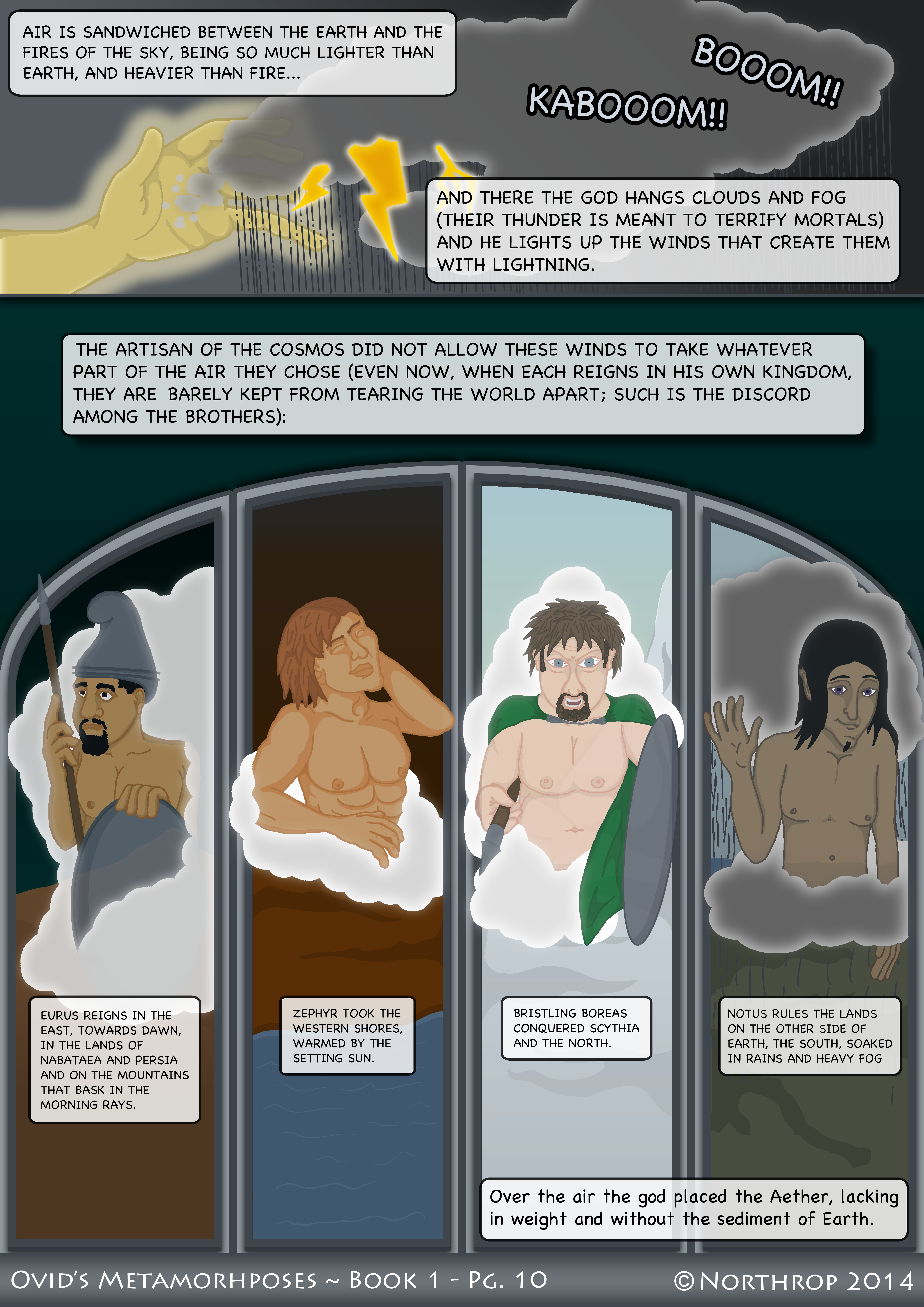Met. 1.52-68 – The Winds
IMMINET HIS AER, QUI, QUANTO EST PONDERE TERRAE
PONDUS AQUAE LEVIUS, TANTO EST ONEROSIOR IGNI.
ILLIC ET NEBULAS, ILLIC CONSISTERE NUBES
IUSSIT ET HUMANAS MOTURA TONITURA MENTES
ET CUM FULMINIBUS FACIENTES FULGORA VENTOS.
HIS QUOQUE NON PASSIM MUNDI FABRICATOR HABENDUM
AERA PERMISIT. (VIX NUNC OBSISTITUR ILLIS,
CUM SUA QUIQUE REGANT DIVERSO FLAMINA TRACTU,
QUIN LANEINT MUNDUM; TANTA EST DISCORDIA FRATRUM.)
EURUS AD AURORAM NABATAEAQUE REGNA RECESSIT
PERSIDAQUE ET RADIIS IUGA SUBDITA MATUTINIS;
VESPER ET OCCIDUO QUAE LITORA SOLE TEPESCUNT
PROXIMA SUNT ZEPHYRO; SCYTHIAM SEPTEMQUE TRIONES
HORRIFER INVASIT BOREAS; CONTRARIA TELLUS
NUBIBUS ASSIDUIS PLUVIOQUE MADESCIT AB AUSTRO.
HAEC SUPER IMPOSUIT LIQUIDUM ET GRAVITATE CARENTEM
AETHERA NEC QUIDQUAM TERRENAE FAECIS HABENTEM.
OVER THESE THE AIR HANGS, WHICH, AS MUCH AS IT IS LIGHTER THAN
THE EARTH AND WATER, IS SO MUCH HEAVIER THAN FIRE.
AND THERE HE ORDERED FOG AND CLOUDS TO FORM
AND THUNDER DESTINED TO RATTLE MORTAL MINDS
AND WINDS MAKING FLASHES WITH LIGHTNING.
THESE THE BUILDER OF THE WORLD DID NOT ALSO ALLOW TO HAVE ANY
RANDOM SPOT IN THE AIR (SCARCELY NOW DO THEY KEEP FROM TEARING THE WORLD APART,
WHEN THEY REIGN OVER THEIR GUSTS IN DIFFERENT PLACES;
SUCH IS THE DISCORD BETWEEN BROTHERS).
EURUS RESIDES TOWARDS AURORA AND THE NABATEAN KINGDOM,
THE PERSIAN MOUNTAINS UNDER THE RAYS OF THE MORNING SUN;
THE EVENING STAR AND THE SHORES WHICH ARE WARMED IN THE SETTING SUN
ARE NEAR TO ZEPHYR; BRISTLING BOREAS INVADED SCYTHIA
AND THE NORTH; THE OTHER SIDE OF THE WORLD
IS MADE WET BY IMPOSING CLOUDS AND RAINY AUSTER.
OVER THESE HE PLACED THE AETHER, LACKING AIR’S WEIGHT,
NOR HAVING ANY OF THE SEDIMENT OF EARTH.
Wowzerz… that’s Latin so dense you could cut it with a knife! I’ve tried my best to render it succinctly in this week’s page, and clearly in the translation. It’s not the easiest task, though, and often I’ve had to change subjects of sentences and even reorder lines. I try to stay as literal as possible in my translations, so you can get an idea of what the Latin is doing, but it also needs to be intellegible to average people!
I like the winds as characters; too bad most of them only appear here (Boreas gets his own story in Book 6). At least I can draw them pretty here. There’s a general trend in Hellenistic art to depict places and forces of natura as personified human figures. You get it a lot with places. Unfortunately, I couldn’t find too many pieces depicting the winds. They became popular in Rennaissence art, but only appear sporadically in ancient works. You’ll be bemused* to know that I didn’t follow either tradition in depicting them. The ancients depicted them as typical male bearded figures with wings, flying through the air. Rennaissence and later artists depicted them as effeminate boys with various types of wings, including butterfly wings! (I’m looking at you, Bouguereau) While this is indeed fun, I decided to go a different route. I’m not making a grand statement or anything, I basically just like how I’ve done it. I interpreted them as they appeared to me from Ovid’s description. Thus, Eurus is dressed as a Persian, Zephyr is chilling in the warm evening breeze (looking pretty Spanish too), Boreas is a straight-up viking, and gloomy Notus looks like a goth who just got out of the shower… Not quite butterfly-winged boys, but definitely interesting, if I do say so myself.
You might notice some of the names are different between the text and my version. A lot of mythological figures have multiple names. This makes sense considering the Latin and Greek languages, plus the local versions and various religious cults that had to be brought into the fold when considering religion of the Greek and Roman world; they all contribute a flurry of names. I simply have been ‘correcting’ them to the most common versions (except in cases where the sense of the story is lost by doing so). We like to think of mythology as a single, monolithic institution, with a neat canon of stories and relations. This is far, far, faaaaaaaar from the reality of the ancient world. Different names are the least of the mythographer’s** worries. Cicero perhaps says it best in his book, On the Natura of the Gods (De Natura Deorum): “I should like to know which Hercules we worship is the correct one; indeed, there are many that can be found in recondite literature” (DND 3.42). For many figures of ancient mythology, there are several, even conflicting stories. We’ll encounter this theme later on (Ovid loves alternative versions from recondite literature), but just know that there is a huge cosmos of mythologies out there, and differing names are merely the tip of the iceberg…
*and yes, I do mean it in the sense of it’s dictionary definition.
**”Mythographer”, definition: someone who records and writes up myths.

These are wonderful! I wish I had had something like this to help my son when we were wrestling with Ovid in homeschooling. Thank you! I look forward to the continuing series.
Glad to hear you’re enjoying it! I was homeschooled throughout highschool and I feel that it’s partly what inspired me to begin this project; I believe that education happens everywhere, and I want to make a comic that is both fun, engaging and informative.